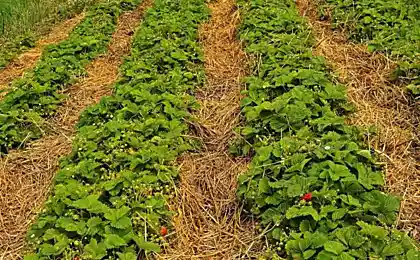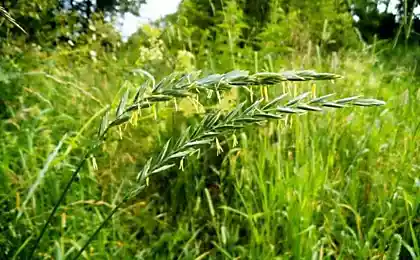158
Using mulch is the secret to a good harvest
Mulching is a well-known agricultural technique. However, many gardeners underestimate the importance and usefulness of mulching.
Mulching is covering the soil between plants with any available material (dust, straw, paper, film, small pebbles, rags, leaffall, peat, humus, cones, etc.). As an option, partially replacing mulching, you can use soil cover plants with a surface root system, which, growing, cover the soil like a carpet. Here it is necessary to take into account the fact that soil protectors should not compete with the main plants, that is, they must be planted among well-received shrubs and trees, as well as perennials with a powerful root system.

What is the importance and usefulness of mulching?
First, mulch from rotting elements serves as nutrition for plants throughout the growing season, In other words, it is a long-term feeding, which comes gradually and long, and without additional efforts of the gardener. Knowing the features of the development of certain plants, you can choose the optimal mulch for each of them.
Secondly, mulch helps fight weeds. Materials such as film, cardboard, rags allow you to get rid of even malicious perennial weeds, such as wheatgrass, ass and others. If you put under the bushes a thick layer of freshly weeded weeds, it will be possible to rid this land of future weeds, help the earth retain moisture and create a nutrient medium from rotten plants.
Third, mulch eliminates digging, especially those lands that are well structured and not clogged with malicious weeds. Excessive digging violates the structure of the soil, reduces its porosity, formed when plant residues rot, and, consequently, violates the underground respiration of the root system of plants. By the way, if there is a piece of land overgrown with weeds on the site, then putting a thick layer of mulch on it and leaving it, for example, until next year, you can turn this piece into a full-fledged, fertile bed.
Fourth, the use of mulch can reduce watering plants even in hot and dry summer, and constant loosening of the soil. It is known that after rain and abundant watering, it is necessary to loosen the crust formed at the same time, which disrupts the root respiration of plants and the flow of moisture to the roots. When using mulch, this problem disappears.
Fifth, mulch protects plants and fruits from rot and other troubles caused by plant contact with the ground. For example, strawberries (which means “straw berry” in English) are recommended to be lined with straw or covered with film between rows.
Sixth, the use of various improvised materials as mulch allows in some sense to solve the problem of using garbage on the site (film, paper, cardboard, rags, small pebbles, weededs, leaf falls).
Based on the above, we were convinced that mulch is not only useful, but also in many respects simply necessary in the suburban area. It facilitates our work, helps plants to survive adverse periods of vegetation (for example, drought), helps to fight plant diseases caused by putrefactive bacteria and pests, and, therefore, increase the growing season of plants. Mulch can also be used for houseplants. Finally, the purely aesthetic aspect. In my opinion, beds covered with mulches look more well-groomed than beds with plants growing on bare, albeit fertile land.
P.S. And remember, just changing our consumption – together we change the world!
Source: chudo-ogorod.ru/
Mulching is covering the soil between plants with any available material (dust, straw, paper, film, small pebbles, rags, leaffall, peat, humus, cones, etc.). As an option, partially replacing mulching, you can use soil cover plants with a surface root system, which, growing, cover the soil like a carpet. Here it is necessary to take into account the fact that soil protectors should not compete with the main plants, that is, they must be planted among well-received shrubs and trees, as well as perennials with a powerful root system.

What is the importance and usefulness of mulching?
First, mulch from rotting elements serves as nutrition for plants throughout the growing season, In other words, it is a long-term feeding, which comes gradually and long, and without additional efforts of the gardener. Knowing the features of the development of certain plants, you can choose the optimal mulch for each of them.
Secondly, mulch helps fight weeds. Materials such as film, cardboard, rags allow you to get rid of even malicious perennial weeds, such as wheatgrass, ass and others. If you put under the bushes a thick layer of freshly weeded weeds, it will be possible to rid this land of future weeds, help the earth retain moisture and create a nutrient medium from rotten plants.
Third, mulch eliminates digging, especially those lands that are well structured and not clogged with malicious weeds. Excessive digging violates the structure of the soil, reduces its porosity, formed when plant residues rot, and, consequently, violates the underground respiration of the root system of plants. By the way, if there is a piece of land overgrown with weeds on the site, then putting a thick layer of mulch on it and leaving it, for example, until next year, you can turn this piece into a full-fledged, fertile bed.
Fourth, the use of mulch can reduce watering plants even in hot and dry summer, and constant loosening of the soil. It is known that after rain and abundant watering, it is necessary to loosen the crust formed at the same time, which disrupts the root respiration of plants and the flow of moisture to the roots. When using mulch, this problem disappears.
Fifth, mulch protects plants and fruits from rot and other troubles caused by plant contact with the ground. For example, strawberries (which means “straw berry” in English) are recommended to be lined with straw or covered with film between rows.
Sixth, the use of various improvised materials as mulch allows in some sense to solve the problem of using garbage on the site (film, paper, cardboard, rags, small pebbles, weededs, leaf falls).
Based on the above, we were convinced that mulch is not only useful, but also in many respects simply necessary in the suburban area. It facilitates our work, helps plants to survive adverse periods of vegetation (for example, drought), helps to fight plant diseases caused by putrefactive bacteria and pests, and, therefore, increase the growing season of plants. Mulch can also be used for houseplants. Finally, the purely aesthetic aspect. In my opinion, beds covered with mulches look more well-groomed than beds with plants growing on bare, albeit fertile land.
P.S. And remember, just changing our consumption – together we change the world!
Source: chudo-ogorod.ru/
From fur of the sloth can be created to replace antibiotics
New from Toyota with a power plant on fuel cells




















